#max frantz
Text
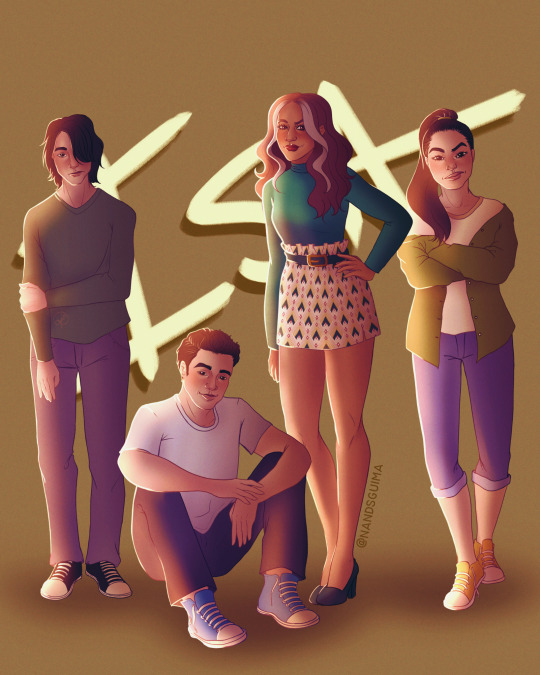
ISA in one of iconic poses of the Breakfast Club
Ngl, I almost forgot about this one 🤡 But here it is!
At least the JSA one won't be alone 🙈
#cindy burman#shiv#injustice society of america#isa#dc stargirl#artemis crock#isaac bowin#cameron mahkent#icicle jr#tigress#the violinist#dc universe#jsa#justice society of america#dctv#hunter sansone#meg delacy#stella smith#max frantz#dccomics#dc fanart#stargirl
48 notes
·
View notes
Note
niceys positive anon!! i don't agree with you on everything but you are so clearly like well read and well rounded that you've helped me think through a lot of my own inconsistencies and hypocrises in my own political and social thought, even if i do have slightly different conclusions at times then u (mainly because i believe there's more of a place for idealism and 'mind politics' than u do). anyway this is a preamble to ask if you have recommended reading in the past and if not if you had any recommended reading? there's some obvious like Read Marx but beyond that im always a little lost wading through theory and given you seem well read and i always admire your takes, i wondered about your recs
it's been a while since i've done a big reading list post so--bearing in mind that my specific areas of 'expertise' (i say that in huge quotation marks obvsies i'm just a girlblogger) are imperialism and media studies, here are some books and essays/pamphlets i recommend. the bolded ones are ones that i consider foundational to my politics
BASICS OF MARXISM
friedrich engels, principles of commmunism
friedrich engels, socialism: utopian & scientific
karl marx, the german ideology
karl marx, wage labour & capital
mao zedong, on contradiction
nikolai bukharin, anarchy and scientific communism
rosa luxemburg, reform or revolution?
v.i lenin, left-wing communism: an infantile disorder
v.i. lenin, the state & revolution
v.i. lenin, what is to be done?
IMPERIALISM
aijaz ahmed, iraq, afghanistan, and the imperialism of our time
albert memmi, the colonizer and the colonized
che guevara, on socialism and internationalism (ed. aijaz ahmad)
eduardo galeano, the open veins of latin america
edward said, orientalism
fernando cardoso, dependency and development in latin america
frantz fanon, black skin, white masks
frantz fanon, the wretched of the earth
greg grandin, empire's workshop
kwame nkrumah, neocolonialism, the last stage of imperialism
michael parenti, against empire
naomi klein, the shock doctrine
ruy mauro marini, the dialectics of dependency
v.i. lenin, imperialism: the highest stage of capitalism
vijay prashad, red star over the third world
vincent bevins, the jakarta method
walter rodney, how europe underdeveloped africa
william blum, killing hope
zak cope, divided world divided class
zak cope, the wealth of (some) nations
MEDIA & CULTURAL STUDIES
antonio gramsci, the prison notebooks
ed. mick gidley, representing others: white views of indigenous peoples
ed. stuart hall, representation: cultural representations and signifying pratices
gilles deleuze & felix guattari, capitalism & schizophrenia
jacques derrida, margins of philosophy
jacques derrida, speech and phenomena
michael parenti, inventing reality
michel foucault, disicipline and punish
michel foucault, the archeology of knowledge
natasha schull, addiction by design
nick snricek, platform capitalism
noam chomsky and edward herman, manufacturing consent
regis tove stella, imagining the other
richard sennett and jonathan cobb, the hidden injuries of class
safiya umoja noble, algoriths of oppression
stuart hall, cultural studies 1983: a theoretical history
theodor adorno and max horkheimer, the culture industry
walter benjamin, the work of art in the age of mechanical reproduction
OTHER
angela davis, women, race, and class
anna louise strong, cash and violence in laos and vietnam
anna louise strong, the soviets expected it
anna louise strong, when serfs stood up in tibet
carrie hamilton, sexual revolutions in cuba
chris chitty, sexual hegemony
christian fuchs, theorizing and analysing digital labor
eds. jules joanne gleeson and elle o'rourke, transgender marxism
elaine scarry, the body in pain
jules joanne gleeson, this infamous proposal
michael parenti, blackshirts & reds
paulo freire, pedagogy of the oppressed
peter drucker, warped: gay normality and queer anticapitalism
rosemary hennessy, profit and pleasure
sophie lewis, abolish the family
suzy kim, everyday life in the north korean revolution
walter rodney, the russian revolution: a view from the third world
#ask#avowed inframaterialist reading group#i obviously do not 100% agree with all the points made by and conclusions reached by these works#but i think they are valuable and useful to read
934 notes
·
View notes
Text
Round Two


Bob Marley and the Wailers
Defeated opponents: Max Webster
Formed in: 1963
Genres: Reggae, ska, rocksteady
Lineup: Bob Marley – lead vocal, rhythm guitar, acoustic guitar
Aston "Family Man" Barrett – bass, piano, guitar, percussion
Carlton Barrett – drums, percussion
Carlton "Santa" Davis – drums
Tyrone Downie – keyboards, backing vocal
Alvin Patterson – percussion
Junior Marvin – lead guitar, backing vocal
Earl Lindo – keyboards
Al Anderson – lead guitar
I Threes (Rita Marley, Marcia Griffiths and Judy Mowatt) – backing vocals
Albums from the 80s:
Uprising (1980)
Confrontation (1983)
Legend (1984)
Rebel Music (1986)
Propaganda:
Talking Heads
Defeated opponents: Los Lobos
Formed in: 1975
Genres: New Wave
Lineup: David Byrne- lead vocals/guitar
Chris Frantz- drums
Tina Weymouth- bass
Jerry Harrison- keyboard/guitar
Albums from the 80s:
Remain in Light (1980)
Speaking in Tongues (1983)
Little Creatures (1985)
True Stories (1986)
Naked (1988)
Propaganda:
#round 2#bob marley and the wailers#talking heads#bob marley#aston barrett#carlton barrett#Carlton davis#Tyrone downie#Alvin patterson#junior marvin#earl lindo#al anderson#david byrne#chris frantz#tina weymouth#jerry harrison#the hottest 80s band tournament#the hottest 80s band tourney
19 notes
·
View notes
Text
Why so many mentions of Barb in S4? Because it's not just about Nancy
@chirpsythismorning @lilitblaukatz I finally have a theory. I didn't understand what all those mentions meant until I found another one in 4x01.
A hidden reference, in a school project, to Barbara Henry, the woman who teached little Ruby Bridges, the first African-American child to attend the all-white William Frantz Elementary School, New Orleans. Barbara, Henry and William. And El had Henry as a mentor...
EDIT (spoiler of The First Shadow) There's another mention in . The name of main character of the play in the play (Joyce's play) the Dark of the Moon, is Barbara Allen.
So, if most of these Barb mentions/references are connected to Will and El, maybe she's not just important for Nancy's arc, but the writers are also using her story to hide hints about Will and El's story.
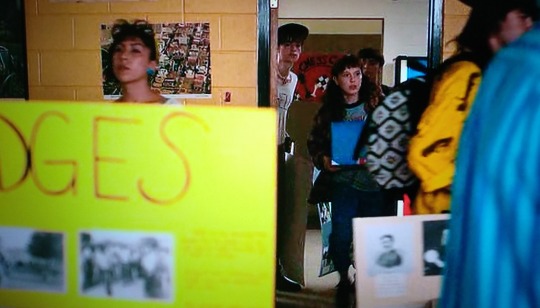

I talk about the references here and here. For example, Lenora is in Santa Barbara County, the hint being 805, the area code number on the Surfer Boy Pizza van. There are two Barbaras in Brenner's crossword puzzle, the day of the massacre. This means twin imagery= Willel (and Henry/Edward) and maybe different timelines.
Another twin imagery is in S2. The owls.
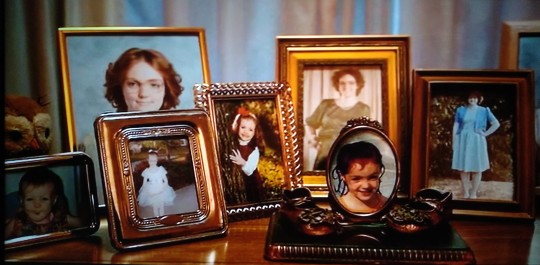

Also, Rick's house, where Eddie is hiding, is at 2121, Holland RD. Barbara Holland. 2121, another twin imagery, and 12 mention (the number associated with Will), but reversed. Rick is a reference to Dr Richard Brenner, mentioned in two articles in S1 (here). One of them is The boy who came back to life. The kids also say that there are 12 Ricks... I don't think these are coincidences.
So, S1 is all about the boy in the UD and the girl who escaped from the lab. Brenner refers to them as the boy and the girl. Will and El, the keys to save the world. In fact, this is the first question Joyce asks after Will's vanishing: 'Where are they?' (the keys) After they showed a key on the wall and keys on the table in Hopper's house.

(screenshot by chirpsythismorning)
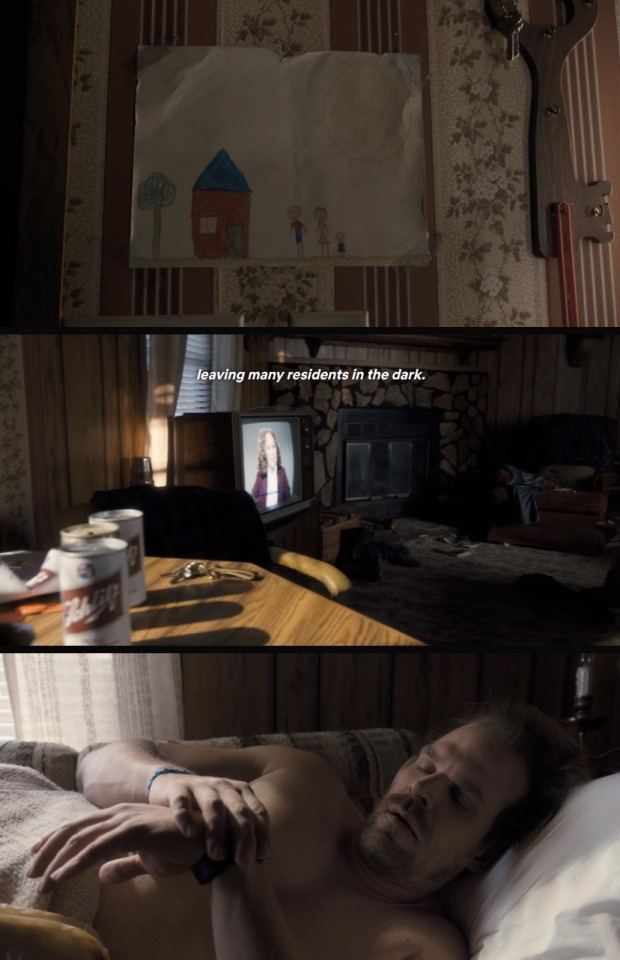
Also, close up of the number of Hopper's badge, in his first scene: 380 (11) Imo, a hint that Will and El are the keys, and Joyce and Hopper are their parents.

But S1 is also about finding Will and another girl, Barb. So my theory is that Barb represents El and the writers hid some important hints in their parallels.
The boy and the girl
Barb is bleeding when she's taken to the UD, and her attack is different from what happens to Will. But she's attacked right after the scene in Will's room, where Should I stay or should I go starts playing, and the light gets brighter, something that only happens when El and Vecna use their powers. Also, Joyce sees the Demogorgon in the wall. They connected Barb to Will.
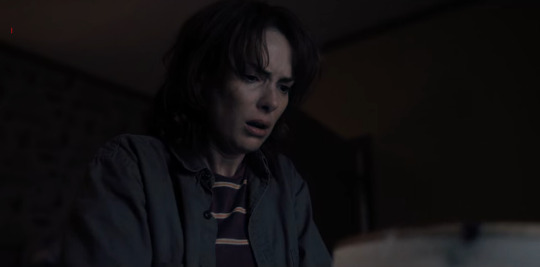
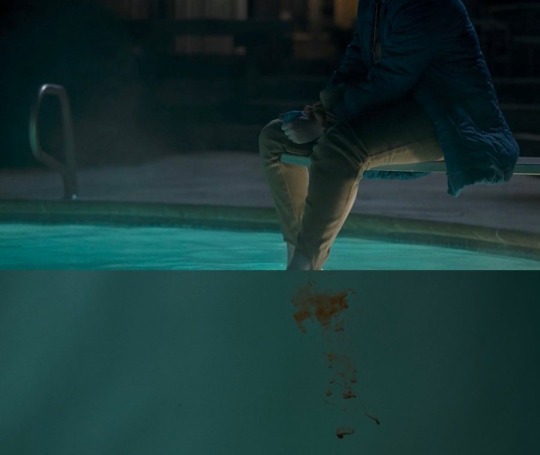
Another connection. El finds them in the void, and Joyce helps her. She helps El to find the boy and the girl, a parallel with her trying to find the keys in 1x01. And if Will is one of the keys, Barb represents the other key, El.


If this is true, what are the hints about Will and El's story?
1. Water. They find Will's fake body in the quarry, and in S1 there are random shots of lakes. Something bad happened in the past (more here and here)
Barb is taken in a pool, and water is important in the show, but it's mostly associated with danger/death. They mention another death in the quarry in 1976. Will has the first vision of the UD in 1x08, when he's washing his hands, and a vision of the Mind Flayer after he washes them in S2. El sees Heather in the bathtub, Billy sees the Mind Flayer in the shower. The song when Hopper and Joyce revive Will (I don't want to swim forever... When it's cold I'd like to die- the same song that plays when Max dies). And Owens says that El is going to drown in the water tank.
This scene in S2 also seems to hint at a parallel between El and Maria's drowning scene in the movie Frankenstein.

The word LIFE


El and a bathtub

And after the shot of Maria walking towards the lake, they show the radio and the number 11. Maybe this means that in the past El died, too, and was revived?
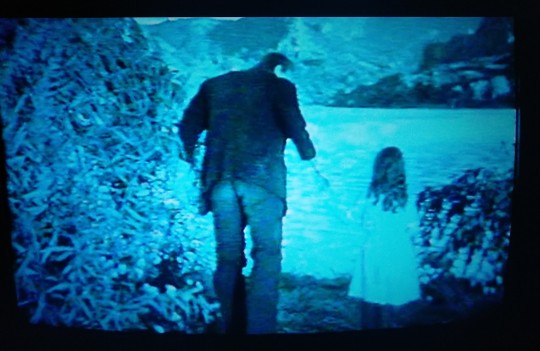

Also, the first time Will communicates with Joyce, she only hears him breathing. Then she tells Hopper that she knows her son's breathing. But in 1x08 Will is not breathing. In S2, when he sees the storm, he feels frozen, like when you can't breath or move or do anything. He says it again in S3, three times. In S2 Becky says that Jane wasn't breathing, and the first thing Terry says to El is: Breath.
And this is also connected to the other big hint hidden in Barb's story.
2. The official "cause" of her death, the experimental chemical asphyxiant (so she couldn't breath) is a parallel with Agent Orange and a hint about the real connection between Willel and Hopper
In S3, Will, El, Hopper and Joyce are all connected to the word orange. I didn't notice it when I watched S3 years ago, because I didn't know Hopper's backstory, but now...
Robin sees a pretty girl with read hair and says: 'Twelve o'clock!' Orange and 12 mention. Will.

Then El explodes the cup of another girl. Curiously, another redhead. Imo, another twin imagery that connect the two scenes. Also, there are four cups: Hopper, Joyce, Will and El. And the guy's outfit reminds me of a lab orderly. (I'm not forgetting Jon. I just thinks he is Lonnie's son)


In this shot the word orange is behind Lucas, but he's telling Hopper that the Mind Flayer destroyed his cabin: Hopper's connection to the events of 1959 and the curse are haunting him and his family?

Then my favorite part, because it connects all of them to Agent Orange and the keys.
Murray gives Jon and Nancy the keys of his house.

Then we see one of the keys, Will, with Joyce. When she hugs him he says that he can't breath.
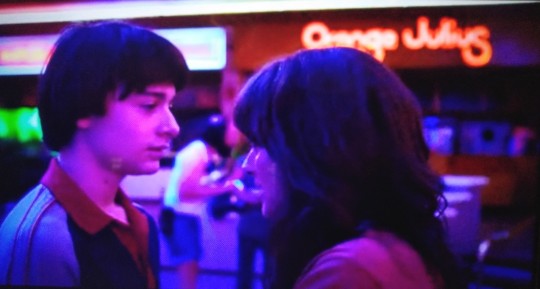

And even when the camera moves on Hopper and El, we can still hear him saying 'I'm suffocating'.

The word orange between the parents (another screenshot by Jo)
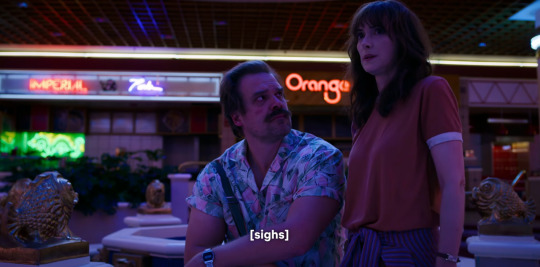


And here. Billy (William), El and the Mind Flayer/Henry, the other person connected to the curse.

The reason why I decided to analyze Barb's connection to Will and El is a strange detail in S4.
When El blames Brenner for all the deaths, the flashback shows Bob's death first, then Barb's. But in 4x02 the journalist says that it all started with Barb's death. I'm not sure what this "error" means. The only thing I could think of is the score at the Arcade in S2.
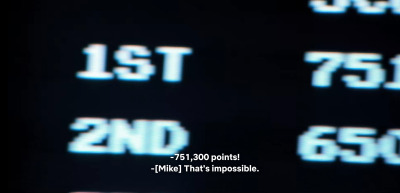
1st, 75 (12) 2nd 65 (11)
11 comes before 12 but in the Dig Dug score it's second. Barb dies before Bob, but in the flashback they show her death after his. Maybe this is also about something in Will and El's past? There's still a lot to analyze.
And, of course, Barb is very important for Nancy's arc, too. I just noticed a connection to other characters and wanted to see what it could mean.
#willel twins#willel literal twins#twelvegate#will byers#el hopper#jopper#joyce byers#jim hopper#barb holland#st parallels#st theory#st analysis#stranger things
39 notes
·
View notes
Text
The Lodge

Though both were developed at the same time, so it’s not likely one is aping the other, Severin Fiala and Veronika Frantz’s THE LODGE (2019, Max, Hulu) has more than a little in common with Ari Aster’s HERIDITARY (2019). Both feature eerie miniature rooms that reflect the action, in this case a dollhouse modeled on the film’s main setting, a remote country house. Both feature cults, though the one in THE LODGE is part of the leading lady’s back story. Both have strong casts delivering good performances. Both got surprisingly strong reviews from the “we only love horror if it’s bloodless” camp. And both have scripts I found problematic if not downright loathsome. In THE LODGE, a man (Richard Armitage) informs his estranged wife (Alicia Silverstone) that he wants a divorce so he can marry his mistress (Riley Keogh). So, Silverstone kills herself, though I suspect she saw the script and told her management team, “Get me the hell out of here!” Armitage is left with two kids (Jaeden Martell and Lia McHugh) who understandably resent his future wife, so he decides the logical thing to do is force them to spend the Christmas holidays together in his lodge while he works. This isn’t the best idea under any circumstances. The fact that Keogh is the sole survivor of a religious cult whose members, led by her father (played by Keogh’s father Danny Keogh) committed mass suicide, and she’s heavily medicated, just makes it harder to swallow. Then, of course, strange things start happening. Keogh and the children wake up one morning to discover the power off, all their phones dead and all their stuff, including Keogh’s medication and most of the food, missing. Is the cult back? Is the house haunted? Is Keogh doing this all without realizing it? Working with cinematographer Thimios Bakatakis, Fiala and Frantz shoot it all quite well, with off-kilter camera angles and eerie shots of the snowy countryside and the house’s interior. But when all is revealed, the stupid catches up with them, and you may be left wondering “What were they thinking?” SPOILER: There’s a dog, and it dies. Maybe he read the script, too.
3 notes
·
View notes
Text
About me.
I, Frantz Dominic, am 24 years old. I go by any pronouns.
Meet him: A passionate bookworm with a deep love for literature and language. With an enthusiastic appetite for books, I can often be found lost in the pages of a book while listening to music all the time.
I usually speak English and Bahasa Indonesia on my account. I can speak a bit of Deutsch and currently learning Spanish.
I love to read classic books, especially German literature. My favorite books are Faust and The Sorrows of Young Werther by Johann Wolfgang von Goethe. The legendary book, The Metamorphosis by Franz Kafka is the best book I've ever read. A Little Life, Max und Moritz and many more.
I have a keen interest in movies, appreciating the art of visual storytelling, cinematography and the magic of cinematic narratives. Whether diving into the complex plots of books or indulging in the cinematic experience of a film, I, find joy and inspiration in the power of words and imagery of it. I love Christopher Nolan, Wes Anderson and Robbert Eggers: So, most of my favorite movies come from them. I watch all genres.
I watch a lot of Anime. From Gintama to Mashle: Magic and Muscle.
I listen to music all the time. I listen to all genres as long as they sound good to my ears (Really). However, I'm a music enthusiast with a soul tuned to the beats of R&B and Soul, British rock, and the hardcore Metal. I used to be an emo kid so we can't just leave our national band alone: My Chemical Romance. I'm a big fan of SZA, Frank Ocean, Brent Faiyaz and Car, The Garden. I love classic bands: QUEEN, ABBA, The Cures, Radiohead, U2 etc. You can see my favorite lists If I update Spotify on my timeline. Glad that we have the same taste.
I love ENHYPEN and lots of girl groups. LE SSERAFIM caught me the most. My favorite is Jennifer Huh. You'll see me update her and go insane after it.
I'm ONLY using Sunghoon as my PFP. Cyber purposes.
Don't mind me who likes to reply to your tweets and interact.
DNI: If you're problematic, won't interact, and a minor.
1 note
·
View note
Text
Holidays 7.20
Holidays
The Binding of the Wreaths (Lithuania)
Cleat Dancing Day
Common Mullein Day (French Republic)
Deepfake Awareness Day
Dia del Amigo (Argentina, Brazil, Uruguay)
Engineer’s Day (Costa Rica)
Falun Gong Persecution Anniversary Day (China)
Frantz Fanon Day
Friend's Day (a.k.a. Dia del Amigo; Argentina, Brazil, Uruguay)
International Ambigram Day
International Chess Day
International Ride MTB Day
July Plot Anniversary Day
Liam Payne Appreciation Day
Lempira Day (Honduras)
Mammal Day
Man on the Moon Day (a.k.a. Moon Day)
Nap Day
National Biplane Day
National Dental BIller’s Day
National Heroes Day
National Megan Day
National Moon Day
National Natalie Day
National Pennsylvania Day
National POW-MIA Recognition Day
National Secretary Day (Mexico)
National Tell A Girl She's Beautiful Day
Peace and Freedom Day (North Cyprus)
Space Exploration Day
Special Olympics Day
Sumarauki (Iceland)
Sun’s Rest Festival (Elder Scrolls)
Tree Planting Day (Central African Republic)
Ugly Truck Day
Vigil for Peace, Justice and Respect for Human Rights (Colombia)
Women’s Union Day (Laos)
World Jump Day
Food & Drink Celebrations
Fortune Cookie Day
International Cake Day
National Ice Cream Soda Day
National Lasagne Day
National Lollipop Day
National Milkshake Day (Australia)
National Strawberry Rhubarb Pie Day
3rd Thursday in July
Get To Know Your Customers Day [3rd Thursday of each Quarter]
Latitude Festival (Suffolk, UK) [3rd Thursday thru Sunday]
Independence Days
British Columbia Province Day (Canada; 1871)
Colombia (from Spain, 1810)
Libernesia (Declared; 2022) [unrecognized]
Republic of Plymouth (Declared; 2015) [unrecognized]
Samana Cay (Declared; 2008) [unrecognized]
Feast Days
Ansegisus (Christian; Saint)
Apollinaris of Ravenna (Christian; Saint)
Aurelius, Bishop of Carthage (Christian; Saint)
Barsabas (Christian; Saint)
Ceslas (Christian; Saint)
Ealhswith (a.k.a. Elswith; Christian; Saint)
Editha (Christian; Saint)
Elias (Christian; Prophet)
Elijah (Christian; Saint)
Elizabeth Cady Stanton, Amelia Bloomer, Sojourner Truth, and Harriet Ross Tubman (Episcopal Church (USA))
Feralia: Day of Purification(Pagan)
Greater Bajram (Feast of Sacrifice; Albania, Bosnia & Herzegovina)
Interstellar Lasagne Day Day (Pastafarian)
Jerom Aemiliani (Christian; Saint)
John Baptist Yi (Christian; One of The Korean Martyrs)
Justa and Rufina (Christian; Martyrs)
La Fontain (Positivist; Saint)
Larry the Fish (Muppetism)
Margaret the Virgin (a.k.a. Margaret of Antioch; Christian; Saint)
Max Liebermann (Artology)
Perun’s Day (Asatru/Slavic Pagan God of Thunder)
Pope John XII Day (Church of the SubGenius; Saint)
Synoika (Ancient Greece)
Thorlac (Christian; Relic Translation)
Turkish Invasion Day (Cyprus)
Uncumber (Christian; Saint)
Ulmer (a.k.a. Wulmar; Christian; Saint)
Wilgefortis (cult suppressed)
Lucky & Unlucky Days
Tomobiki (友引 Japan) [Good luck all day, except at noon.]
Premieres
Batman: Hush (WB Animated Film; 2019)
Breaking Away (Film; 1979)
The Bridge of San Luis Rey, by Thornton Wilder (Novel; 1927)
Buddy Steps Out (WB LT Cartoon; 1935)
Christmas in Connecticut (Film; 1945)
The Dark Knight Rises (Film; 2012)
Do You Believe in Magic?, by The Lovin’ Spoonful (Song; 1965)
Ghost World (Film; 2001)
Hairspray (Film; 2007)
Hedwig and the Angry Inch (Film; 2001)
Like a Rolling Stone, by Bob Dylan (Song; 1965)
Lucky Number (Disney Cartoon; 1951)
Mama Mia!: Here We Go Again (Film; 2018)
The NeverEnding Story (Film; 1984)
Revenge of the Nerds (Film; 1984)
Sid and Nancy (Film; 1986)
Spirited Away (Studio Ghibli Animated Film; 2001)
Stop the World — I Want To Get Off (Musical Play; 1961)
Tabasco Road (WB LT Cartoon; 1957)
Train to Busan (Film; 2016)
The Wind Rises (Studio Ghibli Animated Film; 2013)
Today’s Name Days
Apollinaris, Bernhard, Margareta (Austria)
Ilina, Iliya, Iliyana, Ilko (Bulgaria)
Apolinar, Bernard, Ilija, Margareta, Marina (Croatia)
Ilja (Czech Republic)
Elias (Denmark)
Elias, Erland, Liias (Estonia)
Maaret, Maarit, Margareeta, Marketta, Reeta, Reetta (Finland)
Élie, Marina (France)
Elias, Greta, Margarete (Germany)
Elias, Ilias (Greece)
Illés (Hungary)
Elia, Simmaco (Italy)
Namejs, Ramona, Ritma (Latvia)
Alvydas, Česlovas, Jeronimas, Vismantė (Lithuania)
Margareta, Margit, Marit (Norway)
Czech, Czechasz, Czechoń, Czesław, Eliasz, Heliasz, Hieronim, Leon, Małgorzata, Paweł, Sewera (Poland)
Ilie (Romania)
Eliáš, Iľja (Slovakia)
Apolinar, Aurelio, Elías (Spain)
Greta, Margareta (Sweden)
Elio, Eliot, Eliott, Elliot, Elliott, Marine (Universal)
Edna, Edwin, Edwina, Elias, Elijah, Ellice, Elliot, Elliott, Ellis, Ellison, Neal, Neala, Neil, Neila, Nelson, Niall, Nigel, Niles (USA)
Today is Also…
Day of Year: Day 201 of 2024; 164 days remaining in the year
ISO: Day 4 of week 29 of 2023
Celtic Tree Calendar: Tinne (Holly) [Day 11 of 28]
Chinese: Month 6 (Ji-Wei), Day 3 (Ji-Mao)
Chinese Year of the: Rabbit 4721 (until February 10, 2024)
Hebrew: 2 Av 5783
Islamic: 2 Muharram 1445
J Cal: 21 Lux; Sevenday [21 of 30]
Julian: 7 July 2023
Moon: 8%: Waxing Crescent
Positivist: 5 Dante (8th Month) [La Fontain]
Runic Half Month: Ur (Primal Strength) [Day 7 of 15]
Season: Summer (Day 30 of 94)
Zodiac: Cancer (Day 30 of 31)
0 notes
Text
Holidays 7.20
Holidays
The Binding of the Wreaths (Lithuania)
Cleat Dancing Day
Common Mullein Day (French Republic)
Deepfake Awareness Day
Dia del Amigo (Argentina, Brazil, Uruguay)
Engineer’s Day (Costa Rica)
Falun Gong Persecution Anniversary Day (China)
Frantz Fanon Day
Friend's Day (a.k.a. Dia del Amigo; Argentina, Brazil, Uruguay)
International Ambigram Day
International Chess Day
International Ride MTB Day
July Plot Anniversary Day
Liam Payne Appreciation Day
Lempira Day (Honduras)
Mammal Day
Man on the Moon Day (a.k.a. Moon Day)
Nap Day
National Biplane Day
National Dental BIller’s Day
National Heroes Day
National Megan Day
National Moon Day
National Natalie Day
National Pennsylvania Day
National POW-MIA Recognition Day
National Secretary Day (Mexico)
National Tell A Girl She's Beautiful Day
Peace and Freedom Day (North Cyprus)
Space Exploration Day
Special Olympics Day
Sumarauki (Iceland)
Sun’s Rest Festival (Elder Scrolls)
Tree Planting Day (Central African Republic)
Ugly Truck Day
Vigil for Peace, Justice and Respect for Human Rights (Colombia)
Women’s Union Day (Laos)
World Jump Day
Food & Drink Celebrations
Fortune Cookie Day
International Cake Day
National Ice Cream Soda Day
National Lasagne Day
National Lollipop Day
National Milkshake Day (Australia)
National Strawberry Rhubarb Pie Day
3rd Thursday in July
Get To Know Your Customers Day [3rd Thursday of each Quarter]
Latitude Festival (Suffolk, UK) [3rd Thursday thru Sunday]
Independence Days
British Columbia Province Day (Canada; 1871)
Colombia (from Spain, 1810)
Libernesia (Declared; 2022) [unrecognized]
Republic of Plymouth (Declared; 2015) [unrecognized]
Samana Cay (Declared; 2008) [unrecognized]
Feast Days
Ansegisus (Christian; Saint)
Apollinaris of Ravenna (Christian; Saint)
Aurelius, Bishop of Carthage (Christian; Saint)
Barsabas (Christian; Saint)
Ceslas (Christian; Saint)
Ealhswith (a.k.a. Elswith; Christian; Saint)
Editha (Christian; Saint)
Elias (Christian; Prophet)
Elijah (Christian; Saint)
Elizabeth Cady Stanton, Amelia Bloomer, Sojourner Truth, and Harriet Ross Tubman (Episcopal Church (USA))
Feralia: Day of Purification(Pagan)
Greater Bajram (Feast of Sacrifice; Albania, Bosnia & Herzegovina)
Interstellar Lasagne Day Day (Pastafarian)
Jerom Aemiliani (Christian; Saint)
John Baptist Yi (Christian; One of The Korean Martyrs)
Justa and Rufina (Christian; Martyrs)
La Fontain (Positivist; Saint)
Larry the Fish (Muppetism)
Margaret the Virgin (a.k.a. Margaret of Antioch; Christian; Saint)
Max Liebermann (Artology)
Perun’s Day (Asatru/Slavic Pagan God of Thunder)
Pope John XII Day (Church of the SubGenius; Saint)
Synoika (Ancient Greece)
Thorlac (Christian; Relic Translation)
Turkish Invasion Day (Cyprus)
Uncumber (Christian; Saint)
Ulmer (a.k.a. Wulmar; Christian; Saint)
Wilgefortis (cult suppressed)
Lucky & Unlucky Days
Tomobiki (友引 Japan) [Good luck all day, except at noon.]
Premieres
Batman: Hush (WB Animated Film; 2019)
Breaking Away (Film; 1979)
The Bridge of San Luis Rey, by Thornton Wilder (Novel; 1927)
Buddy Steps Out (WB LT Cartoon; 1935)
Christmas in Connecticut (Film; 1945)
The Dark Knight Rises (Film; 2012)
Do You Believe in Magic?, by The Lovin’ Spoonful (Song; 1965)
Ghost World (Film; 2001)
Hairspray (Film; 2007)
Hedwig and the Angry Inch (Film; 2001)
Like a Rolling Stone, by Bob Dylan (Song; 1965)
Lucky Number (Disney Cartoon; 1951)
Mama Mia!: Here We Go Again (Film; 2018)
The NeverEnding Story (Film; 1984)
Revenge of the Nerds (Film; 1984)
Sid and Nancy (Film; 1986)
Spirited Away (Studio Ghibli Animated Film; 2001)
Stop the World — I Want To Get Off (Musical Play; 1961)
Tabasco Road (WB LT Cartoon; 1957)
Train to Busan (Film; 2016)
The Wind Rises (Studio Ghibli Animated Film; 2013)
Today’s Name Days
Apollinaris, Bernhard, Margareta (Austria)
Ilina, Iliya, Iliyana, Ilko (Bulgaria)
Apolinar, Bernard, Ilija, Margareta, Marina (Croatia)
Ilja (Czech Republic)
Elias (Denmark)
Elias, Erland, Liias (Estonia)
Maaret, Maarit, Margareeta, Marketta, Reeta, Reetta (Finland)
Élie, Marina (France)
Elias, Greta, Margarete (Germany)
Elias, Ilias (Greece)
Illés (Hungary)
Elia, Simmaco (Italy)
Namejs, Ramona, Ritma (Latvia)
Alvydas, Česlovas, Jeronimas, Vismantė (Lithuania)
Margareta, Margit, Marit (Norway)
Czech, Czechasz, Czechoń, Czesław, Eliasz, Heliasz, Hieronim, Leon, Małgorzata, Paweł, Sewera (Poland)
Ilie (Romania)
Eliáš, Iľja (Slovakia)
Apolinar, Aurelio, Elías (Spain)
Greta, Margareta (Sweden)
Elio, Eliot, Eliott, Elliot, Elliott, Marine (Universal)
Edna, Edwin, Edwina, Elias, Elijah, Ellice, Elliot, Elliott, Ellis, Ellison, Neal, Neala, Neil, Neila, Nelson, Niall, Nigel, Niles (USA)
Today is Also…
Day of Year: Day 201 of 2024; 164 days remaining in the year
ISO: Day 4 of week 29 of 2023
Celtic Tree Calendar: Tinne (Holly) [Day 11 of 28]
Chinese: Month 6 (Ji-Wei), Day 3 (Ji-Mao)
Chinese Year of the: Rabbit 4721 (until February 10, 2024)
Hebrew: 2 Av 5783
Islamic: 2 Muharram 1445
J Cal: 21 Lux; Sevenday [21 of 30]
Julian: 7 July 2023
Moon: 8%: Waxing Crescent
Positivist: 5 Dante (8th Month) [La Fontain]
Runic Half Month: Ur (Primal Strength) [Day 7 of 15]
Season: Summer (Day 30 of 94)
Zodiac: Cancer (Day 30 of 31)
0 notes
Text






Stargirl - 2x06 “Summer School: Chapter Six”
Synopsis: THE NEW INJUSTICE SOCIETY MAKES THEIR MOVE — Cindy and her new team make their move against the JSA leading to an epic showdown.
#stargirl#stargirl cw#stills#dcmultiverse#yolanda montez#wildcat#yvette monreal#cindy burman#shiv#meg delacy#beth chapel#doctor mid-nite#anjelika washington#mike dugan#trae romano#isaac bowin#max frantz
98 notes
·
View notes
Text

#bertrand russell#sun yat sen#max stirner#naruto uzumaki#jiddu krishnamurti#frantz fanon#dinner#philosophy#metaphysics#anime
626 notes
·
View notes
Text
Bevir, M 2010, 'Violence,' Encyclopedia of Political Theory, vol.1, SAGE Publications, pp.1399-1402. https://www.doi.org/10.4135/9781412958660.n463
While the question of violence in general is daunting, when considered from the perspective of political theory, it immediately becomes more manageable through a focus on the relationship between violence and politics. In the history of political theory, this relationship has been formulated in different ways by three groups of thinkers. The first, which traditionally includes thinkers as varied as Niccolò Machiavelli, Max Weber, and Vladimir Lenin, is thought to have identified politics—or more precisely, political power—with force, domination, coercion, in short, violence. Hannah Arendt is emblematic of a second group of thinkers who share the definition of violence proposed by this first group while emphatically rejecting its association with political power. Arendt also rejects a third group of thinkers—whose clearest representatives are Georges Sorel and Frantz Fanon—with whom she disagrees on the definition of violence itself. However, something is lost in this conceptual incongruence, as this third group can be seen to propose an understanding of violence that is in many ways compatible with Arendt's formulation of politics.
Violence and the State
Machiavelli is frequently seen as the earliest and least apologetic of political thinkers with regard to the association between violence and politics. Credited with an unsurpassed realism by admirers and considered the very embodiment of evil by detractors, notably Leo Strauss, Machiavelli is seen as the ultimate proponent of might-makes-right political instrumentalism. Such a view relies on chapter 18 of The Prince, in which many have claimed Machiavelli insisted that, in politics, the ends justify the means. Peter Bondanella and John Musa, however, insist that this is a translation error and that the author is merely noting the absence of impartial judges and the need to take the end result into account when judging an action.
Indeed, the traditional view of Machiavelli as purveyor of bare Realpolitik would need to reckon with several other enigmatic moments in the same chapter, in which he associates law with man and force with beasts and further distinguishes between sly beasts like the fox and powerful and violent beasts like the lion. But not all men can shun the beastly parts of their nature, and given Machiavelli's notably critical view of human nature, it remains true that he never excludes the need to resort to beastly measures of any stripe to counter the self-interest of others. The difficulties of navigating the human world lead Machiavelli to distinguish valuable quantities like glory and skill (virtù) from the ambivalences of violence and power, as in his critique of Agathocles the Sicilian in chapter 8.
In fact, the further one moves from the frequently cited chapter 18 of The Prince, the less conventionally instrumental Machiavelli's understanding of violence appears. For if his positive evaluation of Romulus may initially appear to endorse the claim that means justify ends, it serves equally to introduce a qualitative distinction between different kinds of violence: It is not the same, for Machiavelli, to turn violence toward destruction as it is to turn violence toward restoration. Constructive violence can here be read in relation to Machiavelli's innovative view of the productive and generative effects of conflict that would lead him, with the example of the Roman Republic, to defend republicanism as a form of government against those contemporary critics who dismissed it as unstable and anarchic. This defense of republicanism then adds another twist to The Prince, turning Machiavelli's earlier emphasis on military strength as the basis for good laws (chap. 12) toward a view in which proper military organization—specifically, a militia structure—it-self has a politically generative effect that transcends brute domination and points toward more democratic forms of organization.
Much of the instrumental understanding of violence generally attributed to Machiavelli is arguably better located in German sociologist Max Weber (notwithstanding the claim by Reinhard Bendix that both thinkers share a view of society as an object of governance). Unlike Machiavelli, whose objects of analysis oscillated between power and glory, Weber set out more directly from the conundrum of the state, and it is in responding to the question of the preconditions for the very existence of the state that he turns to violence. In so doing, Weber explicitly distinguishes means from ends, insisting in his seminal lecture “Politics as a Vocation” that given the multiplicity of ends toward which states can direct their energies, these cannot define the state as such. Rather, citing Leon Trotsky's similar declaration, the state can only be defined by the means that it employs and that is specific to it: physical force or violence (Gewaltsamkeit). Having set out from the state, Weber defines politics in those same terms, as a struggle over the distribution of power within or between states. However, given Weber's early critique of what he deemed “Sultanism,” he was acutely aware that this brute force that defines state power was insufficient as an understanding of the operation of subjection. Violence toward the populace invoked fear, which for Weber as for Machiavelli was a weak foundation on which to build lasting power: What was missing was the process through which this violence from above was met with consent from below.
It is at this intersection that Weber's concept of Herrschaft—translated alternately as “domination” and “authority”—is central. Historically, Weber identifies three pure types of domination, each of which involves its own form of encouraging legitimation or consent from below: traditional domination indicates a relationship between masters and followers on the basis of an unquestioned and perpetual rule, operating largely through personal relationships; charismatic domination, in which individual leadership qualities are prized over traditional ones; and legal domination, in which consent is granted through administrative mechanisms to laws rather than individuals. It is precisely on the basis of the development of this last form of Herrschaft that Weber is able to argue that the specifically modern state, rather than merely deploying force, instead enjoys a monopoly on its legitimate use. But legitimacy here should not be interpreted as a term of endorsement, as Weber himself would turn to charismatic domination as a potential counterweight to the “iron cage” of modern bureaucracy.
While Lenin insisted in State and Revolution that the ends toward which state violence is directed do matter, he nevertheless agreed with Weber's sociological approach whereby the state is defined in such a way as to accommodate distinct ends (i.e., bourgeois or proletarian). But in so doing, Lenin implicitly rejects the formal universalism of Weber's modern state, in which citizens have come to replace subjects or followers, opting instead for an understanding of the modern state as class rule operating through the same military (monopoly of legitimate force) and bureaucratic (legal domination) institutions that Weber had identified.
Arguing simultaneously against opportunists, for whom the bourgeois state could be seized ready-made, and anarchists, for whom no state could justifiably be seized at all, Lenin argued that bourgeois and proletarian states fundamentally differ even though both qualify as instruments of class domination: The former represent domination of the poor by the rich and the latter the opposite. Hence, the applicability of the concept is maintained without the universalism: To have a proletarian state is still to have a state, but the inversion of domination that it represents clears the way for the second stage, the withering away of the state itself (and violence more generally) through the replacement—on the model of the Paris Commune—of the bureaucratic and military elements of the modern state with a directly democratic and armed communal structure. Hence, although Lenin continues to view violence as pertaining to the state, he nevertheless creates a space, like Machiavelli, for a consideration of qualitatively different types of violence.
Arendt's "Mute Violence"
In both The Human Condition (1958) and On Revolution (1963), Arendt's distaste for violence is clear. In an effort to redefine and reclaim politics, she self-consciously adopts the formulations of Aristotle, which see man as both a political being (zoon politikon) and a speaking being (zoon logon ekhon), thereby tying the political intimately to the phenomenon of speech. If Arendt's understanding of the political is determined both in terms of its location (the polis) and its content (logos), then the same can be said of violence, which is not excluded from her theory but merely relegated to the private sphere of the household (oikos)—the site of labor as opposed to action—and dismissed as the opposite of speech, as silence. Violence, she tells her readers in On Revolution, cannot speak and must therefore be banished from the political realm and left to technicians.
If violence is condemned in the public sphere as the antithesis of politics, Arendt tacitly justifies the function of violence in the private, or household, sphere. For Arendt, the household realm is closely associated with labor, that cyclical, immediate, and inescapable process of fulfilling one's physical necessities. The violence of the ancient household was directly associated with the effort to escape necessity: It was only through enslaving others that one's own necessities could be fulfilled by another, thereby allowing escape from the private world of necessity and entry into the public world of politics. But if the association of violence with labor and necessity is clear in Arendt's work and contributes to her central project of distinguishing the public from the private, the same cannot be said for the concept of work, whose violence is less clearly distinguishable from her understanding of the political.
As the process that creates the durable human world, work necessarily involves an element of violation, an exhilarating violence toward the world in the process of dominating it. Hence, the violence involved in labor and work are not qualitatively different, but merely have different victims and objects: We bind others to the necessity of nature to free ourselves from labor, whereas to engage in work entails a more direct domination of nature. But because work and the relative permanence that characterizes its artifacts—the epitome of which is the work of art, consciously placed beyond usage—transcends the merely private realm of necessity and consumption and enters the public realm of political action, so too does its domineering violence. Thus, if violence in the political realm was categorically condemned, it was indirectly justified in other realms through the exceedingly high premium Arendt would place on politics. This then gives rise to a second reason why she opposes political violence: Not only is it essentially antipolitical in its silence, but it also frequently represents—as in the case of the French Revolution—the violation of the division between public and private that Arendt hopes to preserve, the forced entry of necessity into politics that she so dreads.
While Arendt was heavily influenced by Weber, she disagreed with him on this point, not due to his definition of violence—which they in fact shared—but rather for his association of that violence, through the nexus of the state, with the political realm. Her position toward Machiavelli was equally complex, occasionally dismissing his instrumental view of politics—instrumentality, for Arendt, being a characteristic of work, not action—but occasionally attempting to see in his appeal to leadership (something to be found as well in Weber's appeal to charisma) something more closely related to her own view of the political. This ambiguity toward Machiavelli points us toward a third category of thinkers that Arendt would spare no ink in critiquing. These thinkers differ with Arendt not—as did Weber—on the question of the political, but rather on the question of violence itself, which they see in terms more compatible with Arendt's notion of politics: as a generative force characterized by its capacity to speak.
A Violence that Speaks
French syndicalist Georges Sorel is perhaps the best-known thinker to focus his attention directly on the phenomenon of violence, but it is important not to be misled by what he means by the term. Toward the end of his Reflections on Violence, Sorel observes that his central task was the establishment of a distinction between two phenomena: force and violence. Force indicates the repression of the majority for the benefit of a politically dominant minority embodied in the institutions of the state, whereas violence properly understood represents the liberatory power of the proletariat aimed at destroying that state. Here we have, not an inversion of Machiavelli's discussion of destructive versus reparative violence, but rather continuity under redefined terms: For Sorel, the state is institutionalized destruction, whereas it is proletarian violence that “mends.” Violence, for Sorel, is therefore determined less by its form (i.e., Weber's “physical force”) than by its proletarian content, and this distinction places Sorel in tension with both the realist Weberian tradition that associates politics with violence and the Arendtian tradition that holds them in opposition.
In practice, Sorel's concept of violence functions toward the consolidation of class identity. In the absence of objective class categories and in the face of an increasingly powerful ideology of harmony, Sorel formulated violence—in the form of the general strike—as an intervention capable of rescuing the working class from incorporation into the social totality. Through the violent assertion of social antagonism, the working class would be empowered, the bourgeoisie provoked and scandalized, and the existence of social classes would become more generally salient. The world-historical function of this violence would then, for Sorel, become apparent: By restoring the class division of society in all its purity, the objectivity of Marxist science would also be restored.
It is likely that Fanon read Sorel, despite never citing him. Indeed, Sorel's importance for Francophone discussions of violence was so great that Jean-Paul Sartre—in his preface to Fanon's analysis of violence in The Wretched of the Earth (1961)—went out of his way to dismiss Sorel's relevance entirely. The importance of violence for Fanon's framework is clearly visible in his 1952 work Black Skin, White Masks. In this earlier work, however, Fanon formulates a violence that is almost entirely symbolic, consisting of the violent assertion of one's own existence in the face of onto-logical disqualification. Speaking in Hegelian terms, Fanon insisted that racialized subjects were perceived as nonbeings, and that the only way to create the basis for a Hegelian structure of recognition was through violent appearance. This focus on the symbolic and ontological elements of violence continued throughout Fanon's later work and his relocation to the Algerian context, but the overwhelming and concrete violence of the colonial structure forced him to focus on the violence of the state in a way more reminiscent of Sorel. Against the violence of colonialism, the colonized was to reply with a qualitatively distinct violence that maintains the ontological function of Black Skin, White Masks. If Sorel's violence sought the reestablishment of class identity, Fanon's was oriented toward the construction of national consciousness.
Both Sorel and Fanon celebrate violence in a manner that Arendt finds unacceptable, but what she fails to recognize is the importance of the distinction that both introduce into the term. In her short book On Violence, published at the height of the 1960s tumult, Arendt maintains her assessment of violence as instrumental, while blurring her own categories by recognizing that it is also a form of action. While this might seem like a step toward Sorel and Fanon—as violence is drawn closer to the political—Arendt sees it as even more foreboding than muteness: the unpredictability and irreversibility of action make violence all the more threatening. This is because, if she tacitly recognizes the capacity of violence to speak, it remains monolingual. What Sorel and Fanon embrace is a liberatory violence that operates in much the same way—as noninstrumental, open-ended, transformative, communicative, and creative action—as Arendt's own understanding of politics. But this liberatory violence is held in constant tension with the repressive state violence or force that characterizes more traditional, Weberian accounts of politics. If, for Arendt, ancient slaves were deemed “slavish” in nature for their refusal to resist their own enslavement and fight for their liberty, then nothing could appear less “slavish” than the resignification of violence offered by Sorel and Fanon. And would not her tacit justification of the violence that subdues necessity also lend support to those whose needs have still not been met today?
#philosophy#sociology#violence#hannah miller#machiavllian#niccolo machiavelli#vladimir lenin#max weber#theory#frantz fanon#georges sorel#political philosophy#political theory#sociological theory#revolution
5 notes
·
View notes
Video
youtube
Livros sobre populações africanas e afrodiaspóricas: lista não exaustiva dos livros publicados no Brasil (por Silas Fiorotti).
#books#livros#africa#african people#populações africanas#african studies#estudos africanos#estudos antropológicos em contextos africanos#antropologia#usp#silas fiorotti#youtube#video#achille mbembe#carlos serrano#Elikia M'Bokolo#Max Gluckman#Jonuel Gonçalves#frantz fanon#Alberto da Costa e Silva#History of Africa#História da África#anthropology#Jean-Loup Amselle#Lia Dias Laranjeira#Paulo Fagundes Visentini#Gabriela Aparecida dos Santos#Josué Bila#Wilson Trajano Filho#Omar Ribeiro Thomaz
1 note
·
View note
Photo



MAX FRANTZ as Isaac Bowin
STARGIRL (2020- )
↳ Summer School: Chapter Six
#stargirledit#stargirl#isaacbowinedit#isaac bowin#dcmultiverse#dcugifs#dcblog#userkraina#season 2#2x06#*#by kayleigh
37 notes
·
View notes
Text
I love grief and I love to read about it and wallow in my sadness, so here’s some of my favorite grief moments in books, movies, and tv shows:
- mr Rochester holding onto Jane the morning/dawn after they don’t get married
- last ⅓ of Frantz (French movie)
- pretty much all of us and them. Just like all of it. Nothing left out
- Izzy in city of fallen angels and city of glass after max… I won’t finish the sentence
- Ahsoka two times: when she’s betrayed by the Jedi and when she has to burry the 501st
- good representation of like weird awful happy grief that just makes you want to rip your heart out is the end of Tale of Princess Kaguya :)
- flower of evil <\3
- Outlander season 2 finale GOD what was up with that and then they had the audacity to make us wait for like another 2 years
- watch move to heaven!! If you want to pretend that you deal with death in a healthy way.
#grief#sadness#movies#books#tv shows#movie recommendation#Jane Eyre#Frantz#us and them#izzy lightwood#the clone wars#Ahsoka Tano#the tale of princess kaguya#flower of evil#outlander#move to heaven
17 notes
·
View notes
Text
Max Frantz was actually an amazing actor for his role I’m mad he didn’t get to talk more
23 notes
·
View notes
Text
im so insanely obsessed w max in every single way i want to write a 50 page dissertation on her i want to eat her out for 2 hours i want to force her to read frantz fanon
9 notes
·
View notes